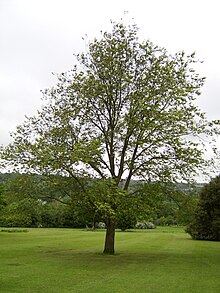Ulmus wallichiana
| Ulmus wallichiana | |
|---|---|
 |
|
| U. wallichiana, Withdean Park, Brighton. | |
| Scientific classification | |
| Kingdom: | Plantae |
| (unranked): | Angiosperms |
| (unranked): | Eudicots |
| (unranked): | Rosids |
| Order: | Rosales |
| Family: | Ulmaceae |
| Genus: | Ulmus |
| Species: | U. wallichiana |
| Binomial name | |
|
Ulmus wallichiana Planch. |
|
| Synonyms | |
|
|
Ulmus wallichiana Planch., the Himalayan elm, also known as the Kashmir elm and Bhutan elm, is a mountain tree ranging from central Nuristan in Afghanistan, through northern Pakistan and northern India to western Nepal at elevations of 800–3000 m. Although dissimilar in appearance, its common name is occasionally used in error for the Cherry Bark Elm Ulmus villosa, which is also endemic to the Kashmir, but inhabits the valleys, not the mountain slopes. The species is closely related to the Wych Elm U. glabra.
The Himalayan Elm grows to 30 m tall, with a broad crown featuring several ascending branches. The bark of the trunk is greyish brown and longitudinally furrowed. The leaves are elliptic-acuminate, < 13 cm long by 6 cm broad on petioles 5–10 mm long. The samarae are usually orbicular, < 13 mm in diameter.
The tree has a high resistance to the fungus Ophiostoma himal-ulmi endemic to the Himalaya and the cause of Dutch elm disease there. However, U. wallichiana was found to be one of the most preferred elms for feeding and reproduction by the adult elm leaf beetle Xanthogaleruca luteola [1] and feeding by the Japanese Beetle Popillia japonica [2] in the United States. Tests in Italy confirmed the American findings, and also determined a moderately high susceptibility to Elm Yellows, meanwhile in the Netherlands the species was also found to be susceptible to coral spot fungus Nectria cinnabarina.
...
Wikipedia

